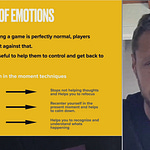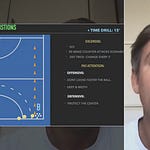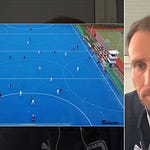If there’s one thing every field hockey coach—at any level—should take from this latest masterclass with Fede Tanuscio, it’s this: breaking down a low zonal block starts with purposeful structure and role clarity, but depends on training your team to master and apply principled flexibility in attack.
This isn’t just about playbooks or running more 2v1 drills. Fede goes beyond diagrams and session plans in breaking down what really works against a compact, low zonal block—one of the defining defensive trends in recent elite tournaments. The session is full of tactical insights, but let’s focus on why this principle matters so much in day-to-day coaching, and how to use it.
Why This Principle?
The first point Fede makes is straightforward: most teams these days default to a low zonal block when under pressure. The numbers from recent top-level games tell the story: even with double-digit circle penetrations, securing meaningful attacking outcomes against this defensive structure is hard work. The low zonal block's aim is clear—limit circle entries and force low-quality shots.
Learning to recognise, coach, and then break down this structure isn’t just for the top only. Wherever you coach, your side will meet teams that sit deep and force the game outside. And this is where clarity of structure and roles—combined with adaptability—must be at the heart of your solution.
How to Use This Principle in Daily Training
So how do you bring it onto your own turf, even with limited time and resources?
Train the Standard "Back Five" Shape. A disciplined shape is non-negotiable for unlocking a zonal block: "That's why the standard structure is playing with a back five at the back… what we want with the back five is to have double width." Train your defenders and wide mids to really stretch the opposition and own the double-width principle.
Rehearse Roles, Not Just Patterns. Fede's breakdown is detailed here: low mid stays opposite to the ball, strikers work as posts and lead inside the D, central defenders make smart infiltrations—not just for show, but to manipulate the structure and manufacture 2v1s within the block.
Overload with Purpose, Especially Right. "One of the things they are doing a lot is overload one side, the right side... you have always more players to combine and get more outcomes in that zone." When you build drills or phase play, deliberately create overloads and rehearse quick switches and central channel attacks.
Balance Rigidity with Player Creativity. Systems matter, but games (and blocks) are broken by moments. As Fede wisely points out: "Leave the part of the creativity as well open and then it's fine. Of course, we have to have standard situations, but if you have players who have that creativity, don't kill the creativity." Your best training environments are those where structured play, quick switches, and rotations exist alongside moments of autonomy.
Use Unders, Not Overs. Fede drills his attacking play in "underdog" situations: always train underload scenarios (strikers vs. more defenders), because that reflects reality and exposes the team to real-game adversity.
"If we can break down the zonal system, and bring it to a man-to-man situation with infiltrations... that is one of the important points."
– Fede Tanuscio
Why Watch the Whole Masterclass?
This session is more than the usual tactics talk. Fede puts everything he observed from Europe’s top games into clear, trainable solutions—how to shape, overload, infiltrate, and when to let creativity off the leash. If you want to see video breakdowns, understand the specific roles and structures that create entries against a deep block, or need practical drills for your own sessions, you’ll find real examples and session plans here. Stay tuned for the detailed breakdown—session design, role specificity, and practical ways to train your players to beat a low zonal block—coming up for our subscribers 👇












